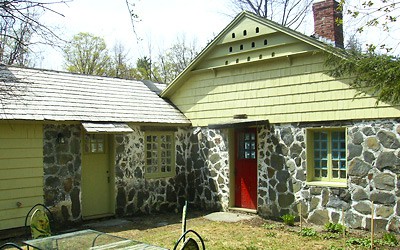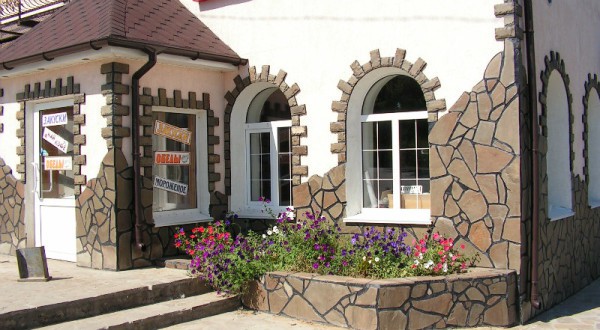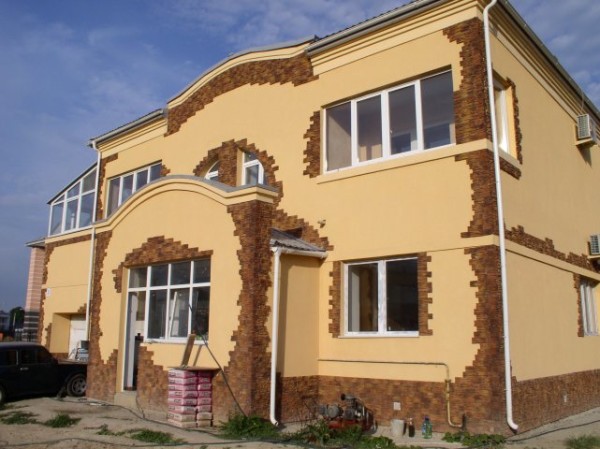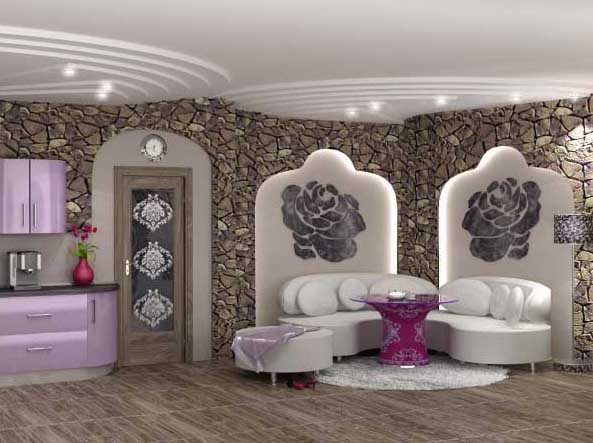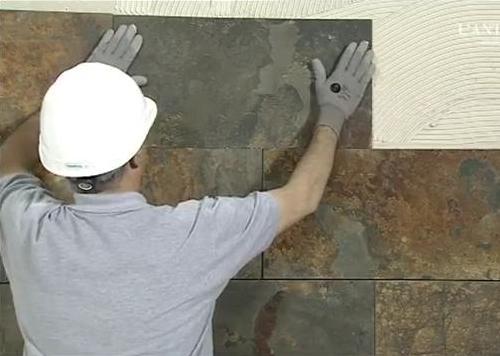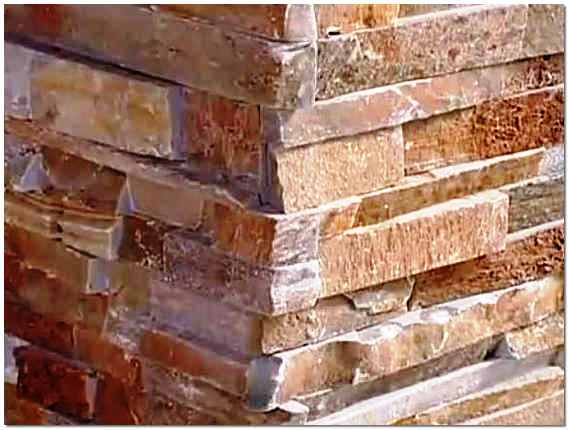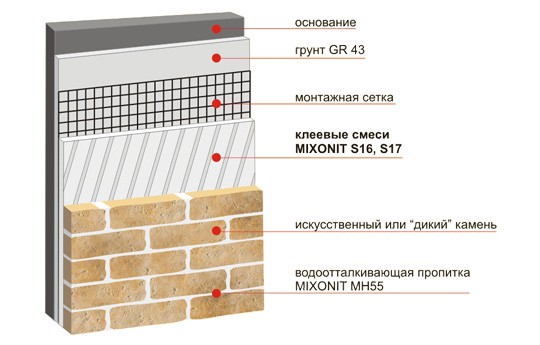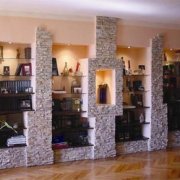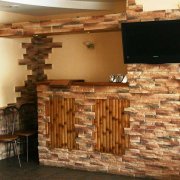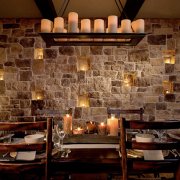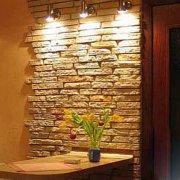Decorating a house with stone: types and stages of work
At the moment, the finishing materials that are used for outdoor work are diverse. Decorating with a stone at home is gaining more and more uniqueness and popularity, which is not only able to protect the surface of the building material, but also give the house a noble appearance.
The content of the article
Types of stones that are used in exterior decoration
Home decoration the stone looks quite original.
For such work currently used:
- Decorative rock.
- Natural stone.
Note. These materials have almost the same technical characteristics, but differ in their cost and are used both in the exterior and interior decoration.
Natural stone in decorating
Natural stone is a natural material, and therefore is notable for its environmental friendliness.
It is used in decoration for a rather long period of time and has high technical indicators, it:
- Lasting.
- Reliable.
- Durable
- Practical.
- Easy to use.
- Does not burn.
- It does not fade under the sun.
- It does not deform under the influence of significant loads.
- Able to withstand temperature changes.
- Moisture resistant.
There are certain types of stones that are quite widely used in decorating.
It:
- Sandstone.
- Marble.
- Granite.
- Slate.
- Shellfish.
- Dagestan stone and so on.
The photo shows a variety of types of stones, which today have found their application in finishing works.
Where is natural stone used?
Decorating a house with natural stone can be both external and internal (seeNatural stone for interior decoration - the elegance of the interior) In order to give the building an original appearance, very often the base of the building is made with natural stone.
It is widely used for decoration of corners of the house. You can combine such a finishing material on the surface with other types.
Material Combinations:
- For example, natural stone looks beautiful with decorative plaster.
- As for interior work, natural stone has found its application for the decoration of countertops, surfaces (walls, floors, window sills), arches, stairs and other decorative elements of the interior.
Features of the installation of natural stone
The installation of natural stone must be carried out already on the surface prepared for these works. To do this, it is leveled if necessary, or visible defects are sealed on it.
Surface preparation for the installation of natural stone
If the installation of natural stone is carried out on the ground floor, then preparatory work can not be carried out, since the basement is built of bricks, which in structure already have a flat surface. If installation is required to be carried out on walls or another surface, then you can not do without preparation.
The preparatory work includes:
- Surface insulation (if the stone is mounted on a wall or floor).
- Alignment.
- Gain.
Stages:
- Initially, insulation works are carried out on the surface, in which solid mineral insulation or foam or polyurethane foam is used.
- They are mounted on the wall with construction glue. If then you need to level the surface, then these works can simultaneously carry out insulation.
Note. Surface leveling is carried out using plaster or drywall. Quite often, instead of the latter, sheets of OSB or durable plywood are used.
Using plaster
The use of such a material is possible only if the surface has visible bumps or spalls. That is, the warming process has been implemented for a long time.
Such a process is encountered on brick or other stone walls.
For such works, starting and finishing plaster is used. They are sold in dry form (loose) and to bring them to the desired consistency there is a certain instruction on the packaging, according to which the required amount of water is added to the solution.
To apply the plaster you will need:
- Two spatulas (large and smaller).
- Solution.
- Level.
- Sandpaper.
- Building grid.
Tip. If then it is planned to mount natural stone on the surface, it is necessary to strengthen it with the help of a reinforcing mesh, which is laid in the starting layer of plaster.
Such actions are due to the fact that natural stone can have a rather large weight, and they help to firmly and reliably fix it to the surface.
Drywall Application
Drywall is often used to level surfaces. It is mounted on the frame from special profiles.
For such purposes, its special type is used - wall GLK. There is also arched and ceiling. Wall drywall differs from other types in its strength and thickness.
For its installation you need:
- Metal profiles.
- Self-tapping screws for mounting drywall (with wide hats).
- Level.
- Simple screws and dowels.
- Screwdriver and hammer drill.
Tip. During the installation of drywall, you can simultaneously warm the structure. Insulation (foam or polyurethane foam) is inserted into the cells of the frame on the surface.
Stages:
- A frame is constructed from metal profiles on the surface, which in its appearance is very similar to a wooden crate.
- Drywall sheets are mounted on it. All joints of the material are glued with a special tape and only then plaster is applied to the surface.
- It is necessary in order to fix the reinforcing mesh on the surface to strengthen the structure.
The whole process can be done with your own hands, since it is not particularly difficult. In the video, it is shown in full.
Installation of natural stone
In order to carry out the installation of natural stone on the prepared surface, it will be necessary to have a concrete mortar, level (in the case of straight-line stone forms) and a spatula.
Installation Instructions:
- Initially, a concrete solution is mixed, which consists of water, cement and sand. You can also add special adhesive to it to give greater strength to the finish.
- The amount of concrete mortar is more dependent on the shape and size of the natural stone. If it has a rounded shape, then more solution will be needed than for the installation of flat natural stone.
A layer of concrete mortar of the required thickness is applied to the surface, which is well prepared. Natural stones "plunge" into it.
Each element of such a finish must be firmly fixed to the surface.
Decorative stone in home decoration
Decoration of houses with artificial stone is also popular.It is used successfully both outside and inside the house.
All this is due to the properties of the material, which:
- Moisture resistant.
- Practical.
- Lasting.
- Durable
- Moisture-resistant (does not apply to gypsum stone, which does not have a protected surface).
- Easy to install.
- Its surface does not absorb dirt.
- It has a small weight.
Tip. Since the artificial stone does not have a large mass, then strengthening on the surface should not be carried out.
It is worth noting that in terms of external parameters, the artificial material is similar to natural material, only the price is several times lower.
There are several types of decorative stones:
- Gypsum.
- Acrylic
- Synthetic.
Finishing Features:
- If it is possible to make gypsum stones on your own and for this you need only gypsum dough, dye and special forms, then other types will not work without specific equipment.
- Finishing the house with artificial stone also begins with leveling the surface with plaster or drywall. In this case, it is not necessary to apply layers of plaster on drywall, since the installation of artificial stone can be carried out directly on its surface.
Tip. Decorative stone is not recommended for use on the floor, as some of its types will not be able to withstand significant loads and will begin to deform.
Where is decorative stone used?
Ways and methods of using artificial stone are similar to natural. It looks very good on walls, arches (seeDecorating an arch with decorative stone - basic rules and requirements), stairs and many other surfaces.
Tip. Do not use a decorative stone to finish a kitchen apron, since the surface of such a material cannot be cleaned properly without the use of abrasive products.
Stages of installing decorative stone
Home decoration with artificial stone is quite simple.
For this you need:
- Concrete or adhesive.
- Level for a rectangular shape.
- Spatula.
- Decorative putty.
Installation:
- Initially, concrete mortar is made from sand, cement and water.
- For such work, you will need a special container and a tool at hand.
- So that the solution turns out to be of high quality and durable, the proportions are 1 to 3 (cement and sand). Water is added as needed.
- The composition of the solution should reach the consistency of very thick sour cream.
Tip. For such work, it will be better to use cement grade 400, which has excellent properties.
- To save a little time, if the surface area for decoration is quite large, then it is more rational to use a concrete mixer. And the solution from this will have a high-quality batch.
Previously, a concrete layer of mortar is laid on the prepared surface, which is also applied to the inner surface of the stone itself. The stone is applied to the surface and exposes in level (if necessary).
Such actions are performed with each element of decoration. After the installation of the artificial stone is completed, you can use decorative putty for joints, but if a coloring agent is added to the concrete or adhesive mortar, then you will not need to use it.
